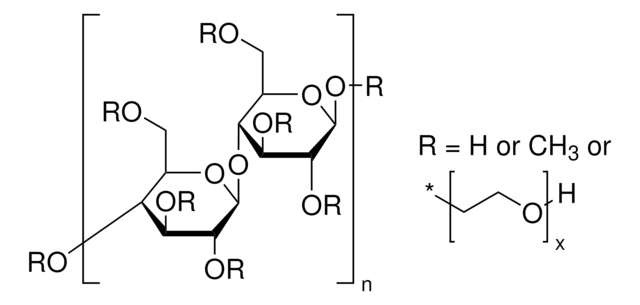308633
2-Hydroxyethyl cellulose
average Mw ~380,000
Synonym(s):
HEC
About This Item
Recommended Products
description
Viscosity:300 - 400 cps, c = 2%; Water at 25° C
Quality Level
form
powder
autoignition temp.
725 °F
mol wt
average Mw ~380,000
extent of labeling
1.0 mol per mol cellulose (D.S.)
2.0 mol per mol cellulose (M.S.)
mp
288-290 °C (dec.)
density
0.6 g/mL at 25 °C (lit.)
SMILES string
O1C(C(C(C(C1CO)OC)O)OCCO)OC2C(OC(C(C2O)O)OC4C(OC(C(C4O)O)C)CO)COC3OC(C(C(C3O)O)OC)CO
InChI
1S/C29H52O21/c1-10-15(34)16(35)24(13(8-33)45-10)49-28-20(39)18(37)25(50-29-26(43-5-4-30)21(40)23(42-3)12(7-32)47-29)14(48-28)9-44-27-19(38)17(36)22(41-2)11(6-31)46-27/h10-40H,4-9H2,1-3H3
Looking for similar products? Visit Product Comparison Guide
General description
Application
Storage Class
11 - Combustible Solids
wgk_germany
WGK 1
flash_point_f
Not applicable
flash_point_c
Not applicable
ppe
Eyeshields, Gloves, type N95 (US)
Choose from one of the most recent versions:
Already Own This Product?
Find documentation for the products that you have recently purchased in the Document Library.
Customers Also Viewed
Our team of scientists has experience in all areas of research including Life Science, Material Science, Chemical Synthesis, Chromatography, Analytical and many others.
Contact Technical Service





